The aforementioned Live Cam video provides evidence that JA722A entered onto runway 34R at intersection C-5 and remained stationary until the impact. As a visual reference, other aircraft DAL276 and JAL545 are seen further to the right, queueing up to intersection C-1. The moment of impact is also captured in a passenger video from on board an aircraft taxiing past C-5.
Previous discussion that JA722A would have entered at C-1 can be eliminated for the stated reasons, but also noting that this intersection is too short of the touchdown zone of runway 34R, and this video (at 1:48) appears to show the burning collision site as seen from a plane that was holding short at C-1 of 34R. Here, too it is clear that there is some distance, about 3 taxiways between the camera and the fire, confirming that the collision must have occurred near to C-5. The Approach Lighting System (ALS) provides visual reference for runway 34R. Despite its name, standard operating procedure is that ALS is used both during takeoffs and landings.
In the press conference held by the Civil Aviation Bureau of the Ministry of Land, Infrastructure, Transport and Tourism and the Japan Coast Guard, where a collision diagram was shown to reporters [2]:
JAL516 touched down on 34R, and while flightradar24 doesn’t show any aircraft on the runway ahead of them, it should be noted that JA722A was not equipped with a modern ADS-B transponder (or its mode S was switched off):
By daylight, the resting positions of both aircraft are plainly visible:
Speculation
According to Japan’s transportation ministry, JA722A was instructed to “taxi to holding point C-5,” and read back that instruction. It nevertheless entered onto the runway without ATC clearance. JA722A had six minutes after the previous departure of JAL25 to maneuver onto the runway for takeoff, and it’s possible that ATC wished to prioritize the departure of delivering earthquake relief aid by shortcutting it onto the runway ahead of the queue of commercial aircraft holding ahead of C-1.
This appears to be standard ICAO phraseology for holding short of a runway at an intersection, where the guidelines provide the following example [13]:
Taxi to holding point C, runway 27, Big Jet 345
It’s possible that JA722A was under the incorrect impression that it was cleared to enter runway 34R at C-5 and hold for takeoff on the runway. The phraseology for doing so, however, is given as an example in the ICAO quick reference guide as:
Big Jet 345, Metro Tower, line up runway 27
The transcript does not include an explicit instruction from ATC to “line up.”
A further insight is regarding the Autonomous Runway Incursion Warning System. According to a NOTAM bulletin, the Stop Bar Lighting at junctions C-1 to C-14 were unserviceable since Dec 27th, as per a NOTAM bulletin. [11, 12]. This stop line is where ATC expected JA722A to stop, ahead of intersection C-5 prior to the runway:
Please observe that currently no concrete evidence has been published to support any hypotheses. Therefore, remember to avoid jumping to conclusions as we do not have all the facts yet.
Open questions
1. Did JA722A enter onto the runway with unambiguous ATC clearance, and if not, why did they do so anyway?
Editorial notes: JA722A did not have ATC clearance to enter the runway, and it appears that ATC used standard ICAO phrasing to instruct the aircraft to hold short of 34R ahead of intersection C-5. [13]
2. Why did ATC radar not trigger an automated collision warning through runway incursion monitoring for JAL516 if JA722A was on the same runway?
3. Why did JA722A not react to and communicate regarding a stop signal from the Autonomous Runway Incursion Warning System (ARIWS)?
Editorial notes: Stop Bar Lighting at junctions C-1 to C-14 were unserviceable since Dec 27th, as per a NOTAM bulletin. [11, 12]
4. Did JA722A have its strobe lights illuminated?
5. Why did neither the tower nor JAL516 see JA722A on 34R?
6. Why didn’t a collision avoidance system activate on board JAL516?
Thank you for the write up. It looks like they need to find out why JA722A actually came to be on the runway. It’s truly amazing that nobody died on the JAL flight.
Aircraft positioning
The aforementioned Live Cam video provides evidence that JA722A entered onto runway 34R at intersection C-5 and remained stationary until the impact. As a visual reference, other aircraft DAL276 and JAL545 are seen further to the right, queueing up to intersection C-1. The moment of impact is also captured in a passenger video from on board an aircraft taxiing past C-5.
Previous discussion that JA722A would have entered at C-1 can be eliminated for the stated reasons, but also noting that this intersection is too short of the touchdown zone of runway 34R, and this video (at 1:48) appears to show the burning collision site as seen from a plane that was holding short at C-1 of 34R. Here, too it is clear that there is some distance, about 3 taxiways between the camera and the fire, confirming that the collision must have occurred near to C-5. The Approach Lighting System (ALS) provides visual reference for runway 34R. Despite its name, standard operating procedure is that ALS is used both during takeoffs and landings.
In the press conference held by the Civil Aviation Bureau of the Ministry of Land, Infrastructure, Transport and Tourism and the Japan Coast Guard, where a collision diagram was shown to reporters [2]:
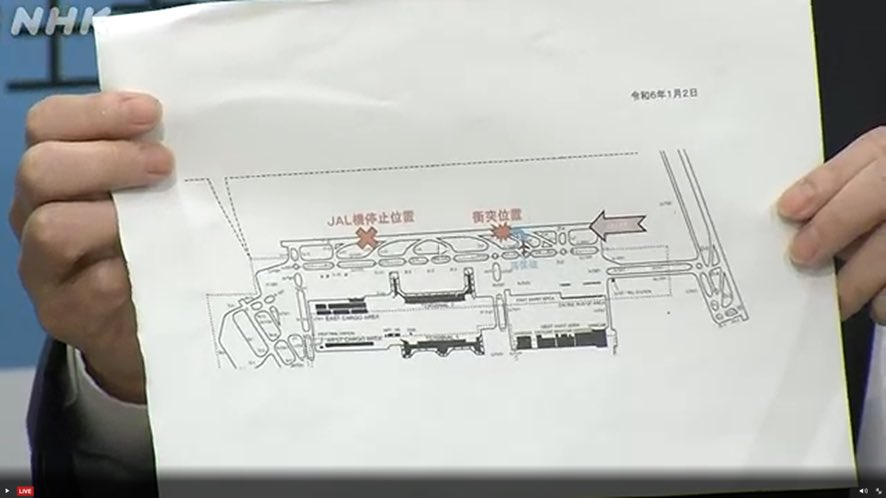
Here I’ve recreated that illustration that labels both intersections C-1 and C-5 on the updated 2022 RTJJ/HND airport chart:
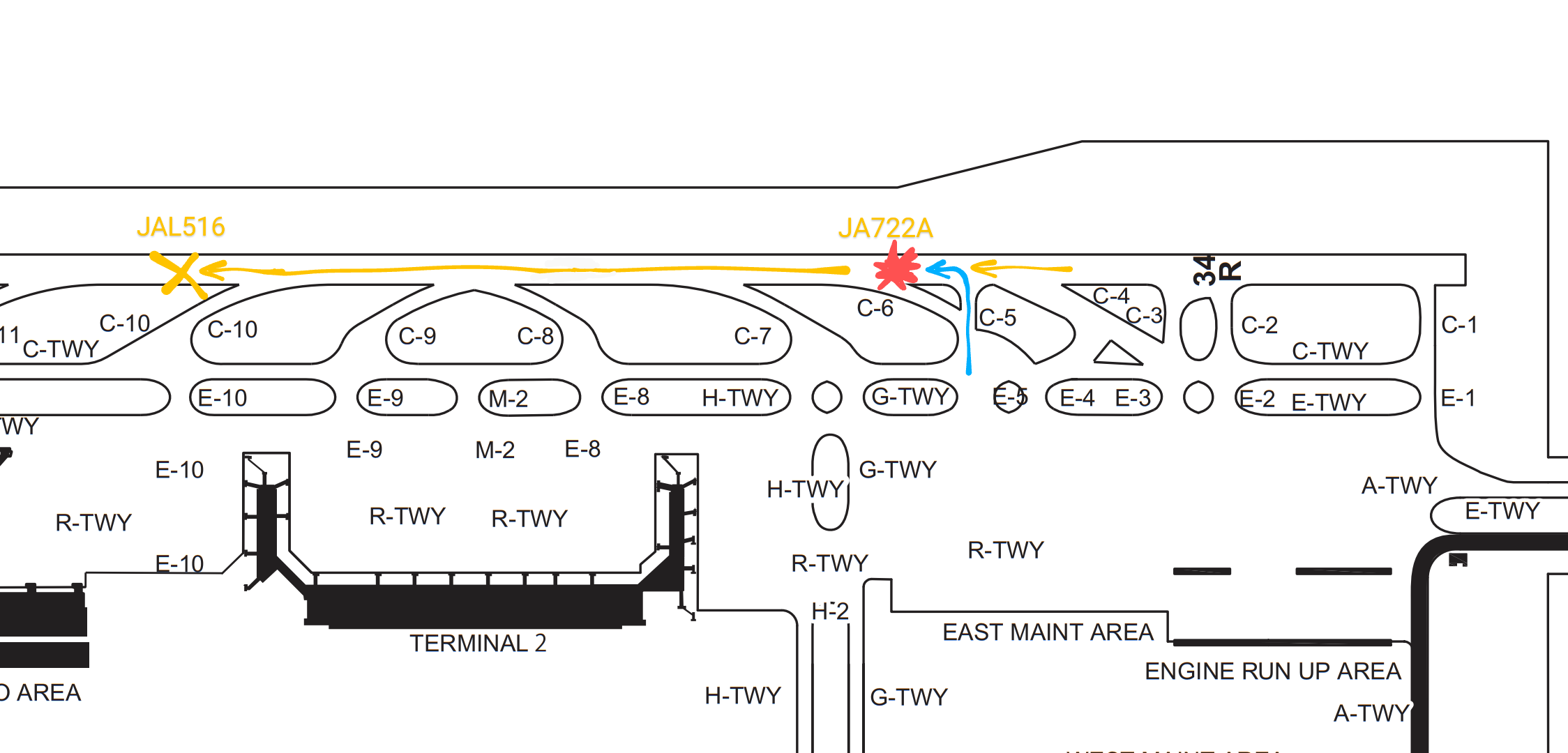
JAL516 touched down on 34R, and while flightradar24 doesn’t show any aircraft on the runway ahead of them, it should be noted that JA722A was not equipped with a modern ADS-B transponder (or its mode S was switched off):
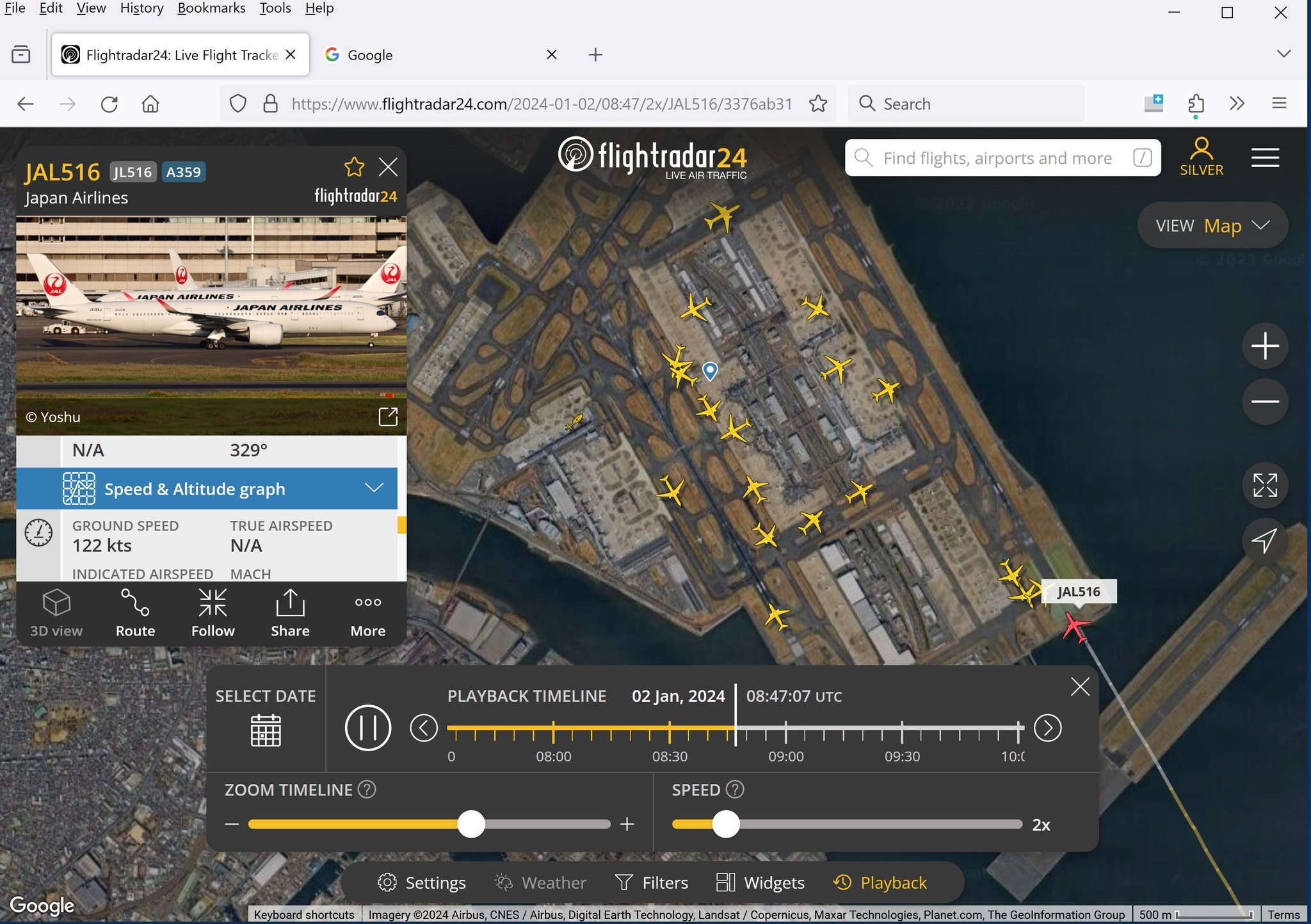
It should be noted that JA722A cannot be reliably tracked by flightradar24 and here’s an explanation why). Despite JA722A having an older model transponder, ATC should have accurately seen it on their ground radar.
By daylight, the resting positions of both aircraft are plainly visible:
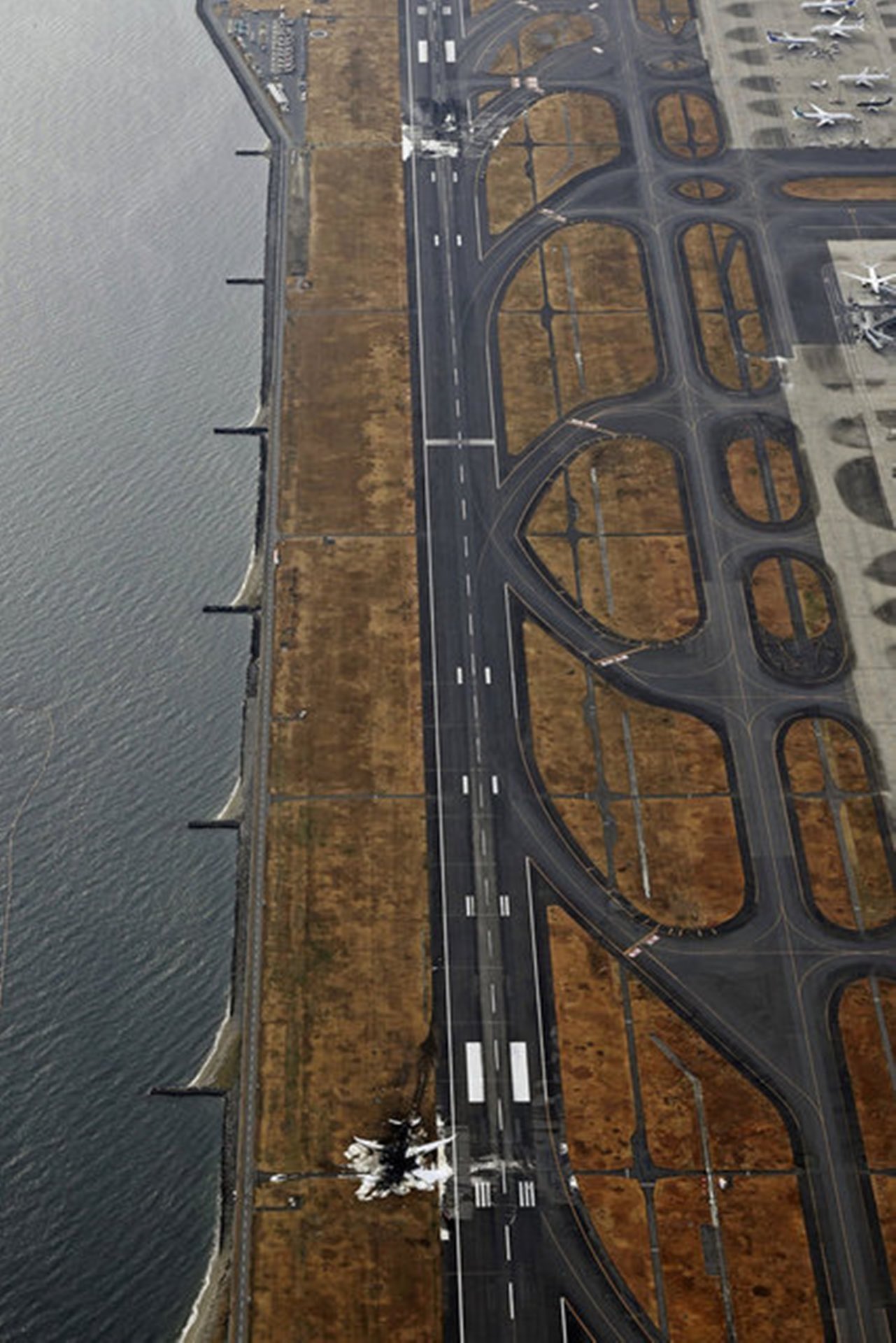
Speculation
According to Japan’s transportation ministry, JA722A was instructed to “taxi to holding point C-5,” and read back that instruction. It nevertheless entered onto the runway without ATC clearance. JA722A had six minutes after the previous departure of JAL25 to maneuver onto the runway for takeoff, and it’s possible that ATC wished to prioritize the departure of delivering earthquake relief aid by shortcutting it onto the runway ahead of the queue of commercial aircraft holding ahead of C-1.
This appears to be standard ICAO phraseology for holding short of a runway at an intersection, where the guidelines provide the following example [13]:
It’s possible that JA722A was under the incorrect impression that it was cleared to enter runway 34R at C-5 and hold for takeoff on the runway. The phraseology for doing so, however, is given as an example in the ICAO quick reference guide as:
The transcript does not include an explicit instruction from ATC to “line up.”
A further insight is regarding the Autonomous Runway Incursion Warning System. According to a NOTAM bulletin, the Stop Bar Lighting at junctions C-1 to C-14 were unserviceable since Dec 27th, as per a NOTAM bulletin. [11, 12]. This stop line is where ATC expected JA722A to stop, ahead of intersection C-5 prior to the runway:
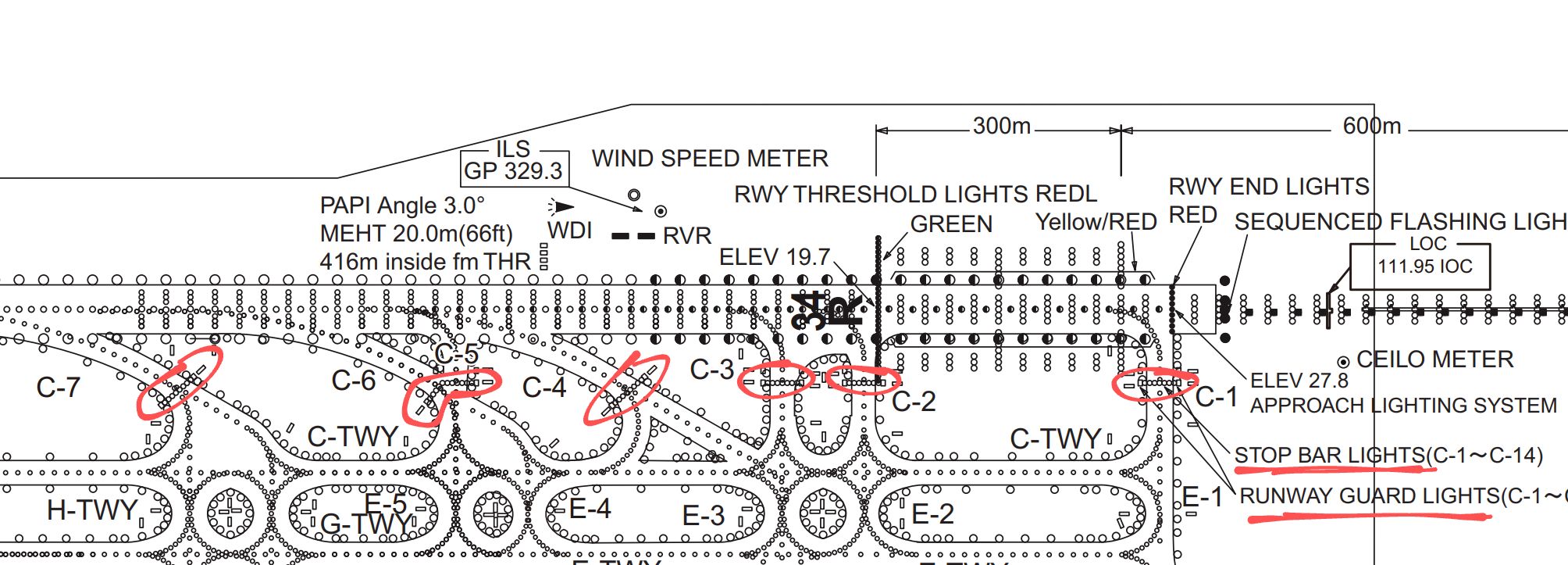
Please observe that currently no concrete evidence has been published to support any hypotheses. Therefore, remember to avoid jumping to conclusions as we do not have all the facts yet.
Open questions
1. Did JA722A enter onto the runway with unambiguous ATC clearance, and if not, why did they do so anyway?
Editorial notes: JA722A did not have ATC clearance to enter the runway, and it appears that ATC used standard ICAO phrasing to instruct the aircraft to hold short of 34R ahead of intersection C-5. [13]
2. Why did ATC radar not trigger an automated collision warning through runway incursion monitoring for JAL516 if JA722A was on the same runway?
3. Why did JA722A not react to and communicate regarding a stop signal from the Autonomous Runway Incursion Warning System (ARIWS)?
Editorial notes: Stop Bar Lighting at junctions C-1 to C-14 were unserviceable since Dec 27th, as per a NOTAM bulletin. [11, 12]
4. Did JA722A have its strobe lights illuminated?
5. Why did neither the tower nor JAL516 see JA722A on 34R?
6. Why didn’t a collision avoidance system activate on board JAL516?
Editorial notes: TCAS is inhibited below 900 feet above ground level. [9]
Closing remarks
The official inquiry will likely focus on the ground radar, ATC transcripts and CVR recordings.
As a reminder, please do not to jump to conclusions as we do not have all the facts yet.
Absolutely phenomenal writeup, thank you for this
Thank you for the write up. It looks like they need to find out why JA722A actually came to be on the runway. It’s truly amazing that nobody died on the JAL flight.